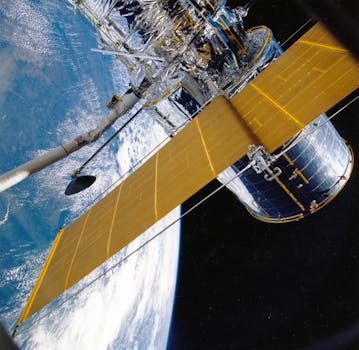
The Future of Satellites: Revolutionizing Global Communication and Exploration
The future of satellites is a rapidly evolving field, with significant advancements in technology and innovation. The focus keyword, Future of Satellites, is at the forefront of this revolution, enabling global communication, exploration, and discovery like never before. Satellites have been a crucial part of our daily lives, providing us with navigation, communication, and weather forecasting. However, the future of satellites holds even more promise, with new technologies and applications emerging every day.
One of the most significant advancements in satellite technology is the development of small satellites, also known as CubeSats. These tiny satellites, weighing less than 1.33 kilograms, are designed to be compact, lightweight, and cost-effective. CubeSats have democratized access to space, allowing smaller organizations and even individuals to launch their own satellites. This has led to a proliferation of satellites in orbit, with over 1,000 CubeSats launched in the past decade alone.
Advancements in Satellite Technology
Another significant advancement in satellite technology is the development of reusable launch vehicles. Companies like SpaceX and Blue Origin have pioneered this technology, significantly reducing the cost of launching satellites into orbit. Reusable launch vehicles have also enabled the development of more complex and sophisticated satellites, with greater capabilities and longer lifespans. For example, the European Space Agency’s (ESA) Gaia satellite has been in orbit since 2013, providing unprecedented detail and accuracy in mapping the Milky Way galaxy.
Satellite constellations are another area of significant development. Companies like OneWeb and Amazon’s Kuiper Systems are launching thousands of satellites into orbit, providing global internet connectivity and bridging the digital divide. These constellations will enable high-speed, low-latency internet access, even in the most remote and underserved areas of the world. This has significant implications for global communication, education, and economic development.
Exploration and Discovery
Satellites are also playing a crucial role in exploration and discovery, enabling us to study the Earth, the Sun, and the universe in unprecedented detail. The NASA’s Parker Solar Probe, launched in 2018, is providing unprecedented insights into the Sun’s corona and the solar wind. The ESA’s BepiColombo mission, launched in 2018, is on a mission to explore Mercury, the smallest planet in our solar system. These missions are expanding our understanding of the universe, its origins, and its evolution.
Satellites are also being used to study the Earth’s climate, weather patterns, and natural resources. The NASA’s Landsat 8 satellite, launched in 2013, is providing high-resolution images of the Earth’s surface, enabling scientists to track changes in land use, deforestation, and climate change. The ESA’s Sentinel-2 satellite, launched in 2015, is providing high-resolution images of the Earth’s surface, enabling scientists to track changes in land use, crop yields, and natural disasters.
Challenges and Opportunities
Despite the many advancements in satellite technology, there are still significant challenges and opportunities that need to be addressed. One of the biggest challenges is the issue of space debris, with thousands of defunct satellites and rocket parts orbiting the Earth. This poses a significant risk to operational satellites and the environment. The development of sustainable and responsible satellite practices is essential to mitigate this risk.
Another significant challenge is the issue of spectrum allocation, with the increasing demand for satellite communications and navigation. The development of new spectrum allocation policies and regulations is essential to ensure that the satellite industry can continue to grow and innovate. The development of new technologies, such as quantum satellites and satellite-based quantum computing, is also an area of significant opportunity and research.





